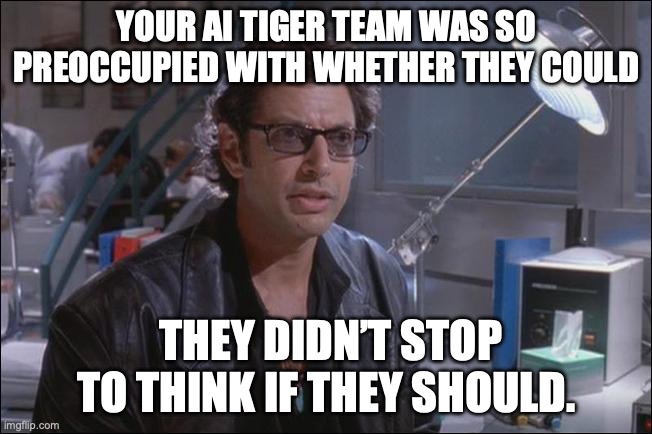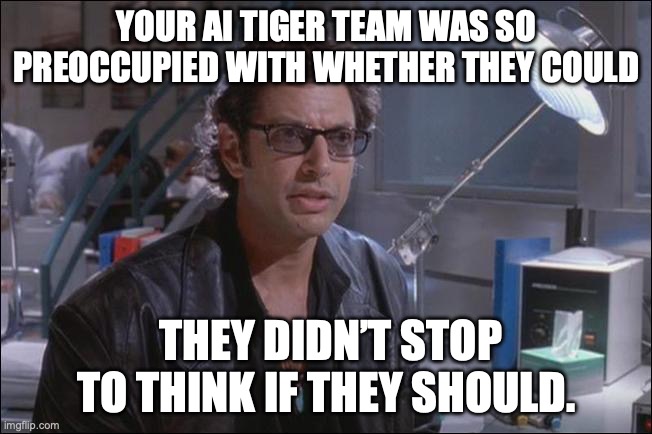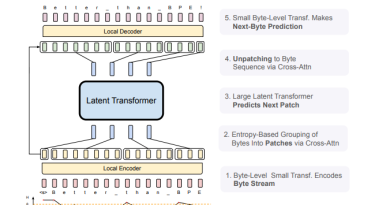Building Ethical AI Starts with the Data Team – Here’s Why
When it involves the know-how race, transferring rapidly has at all times been the hallmark of future success.
Unfortunately, transferring too rapidly additionally means we will danger overlooking the hazards ready in the wings.
It’s a story as outdated as time. One minute you are sequencing prehistoric mosquito genes, the subsequent minute you are opening a dinosaur theme park and designing the world’s first failed hyperloop (however actually not the final).
When it involves GenAI, life imitates artwork.
No matter how a lot we’d like to think about AI a identified amount, the harsh actuality is that not even the creators of this know-how are completely positive the way it works.
After a number of excessive profile AI snafus from the likes of United Healthcare, Google, and even the Canadian courts, it is time to take into account the place we went flawed.
Now, to be clear, I imagine GenAI (and AI extra broadly) will finally be crucial to each industry-from expediting engineering workflows to answering widespread questions. However, with a view to understand the potential worth of AI, we’ll first have to begin considering critically about how we develop AI applications-and the function information groups play in it.
In this put up, we’ll have a look at three moral issues in AI, how information groups are concerned, and what you as a knowledge chief can do at the moment to ship extra moral and dependable AI for tomorrow.
The Three Layers of AI Ethics
When I used to be chatting with my colleague Shane Murray, the former New York Times SVP of Data & Insights, he shared one in all the first occasions he was offered with an actual moral quandary. While creating an ML mannequin for monetary incentives at the New York Times, the dialogue was raised about the moral implications of a machine studying mannequin that might decide reductions.
On its face, an ML mannequin for low cost codes appeared like a reasonably innocuous request all issues thought of. But as harmless because it might need appeared to automate away a couple of low cost codes, the act of eradicating human empathy from that enterprise downside created all types of moral issues for the group.
The race to automate easy however historically human actions looks as if an completely pragmatic decision-a easy binary of bettering or not bettering effectivity. But the second you take away human judgment from any equation, whether or not an AI is concerned or not, you additionally lose the means to straight handle the human influence of that course of.
That’s an actual downside.

Image by creator.
When it involves the improvement of AI, there are three main moral issues:
1. Model Bias
This will get to the coronary heart of our dialogue at the New York Times. Will the mannequin itself have any unintended penalties that might benefit or drawback one individual over one other?
The problem right here is to design your GenAI in such a approach that-all different issues being equal-it will constantly present truthful and neutral outputs for each interplay.
2. AI Usage
Arguably the most existential-and interesting-of the moral issues for AI is knowing how the know-how will likely be used and what the implications of that use-case could be for a corporation or society extra broadly.
Was this AI designed for an moral function? Will its utilization straight or not directly hurt any individual or group of individuals? And finally, will this mannequin present internet good over the long-term?
As it was so poignantly outlined by Dr. Ian Malcolm in the first act of Jurassic Park, simply because you’ll be able to construct one thing doesn’t suggest you must.
3. Data Responsibility
And lastly, the most necessary concern for information groups (in addition to the place I’ll be spending the majority of my time on this piece): how does the information itself influence an AI‘s means to be constructed and leveraged responsibly?
This consideration offers with understanding what information we’re utilizing, beneath what circumstances it may be used safely, and what dangers are related with it.
For instance, do we all know the place the information got here from and the way it was acquired? Are there any privateness points with the information feeding a given mannequin? Are we leveraging any private information that places people at undue danger of hurt?
Is it secure to construct on a closed-source LLM when you do not know what information it has been educated on?
And, as highlighted in the lawsuit filed by the New York Times in opposition to OpenAI-do now we have the proper to make use of any of this information in the first place?
This can also be the place the high quality of our information comes into play. Can we belief the reliability of information that is feeding a given mannequin? What are the potential penalties of high quality points in the event that they’re allowed to succeed in AI manufacturing?
So, now that we have taken a 30,000-foot have a look at a few of these moral issues, let’s take into account the information group’s duty in all this.
Why Data Teams Are Responsible for AI Ethics
Of all the moral AI issues adjoining to information groups, the most salient by far is the difficulty of information duty.
In the similar approach GDPR compelled enterprise and information groups to work collectively to rethink how information was being collected and used, GenAI will drive corporations to rethink what workflows can-and can’t-be automated away.
While we as information groups completely have a duty to attempt to converse into the building of any AI mannequin, we will not straight have an effect on the consequence of its design. However, by conserving the flawed information out of that mannequin, we will go a good distance towards mitigating the dangers posed by these design flaws.
And if the mannequin itself is exterior our locus of management, the existential questions of can and ought to are on a special planet fully. Again, now we have an obligation to level out pitfalls the place we see them, however at the finish of the day, the rocket is taking off whether or not we get on board or not.
The most necessary factor we will do is be sure that the rocket takes off safely. (Or steal the fuselage.)
So-as in all areas of the information engineer’s life-where we need to spend our effort and time is the place we will have the biggest direct influence for the biggest variety of folks. And that chance resides in the information itself.
Why Data Responsibility Should Matter to the Data Team
It appears virtually too apparent to say, however I’ll say it anyway:
Data groups must take duty for a way information is leveraged into AI fashions as a result of, fairly frankly, they’re the solely group that may. Of course, there are compliance groups, safety groups, and even authorized groups that will likely be on the hook when ethics are ignored. But irrespective of how a lot duty will be shared round, at the finish of the day, these groups won’t ever perceive the information at the similar degree as the information group.
Imagine your software program engineering group creates an app utilizing a third-party LLM from OpenAI or Anthropic, however not realizing that you just’re monitoring and storing location data-in addition to the information they really want for his or her application-they leverage a complete database to energy the mannequin. With the proper deficiencies in logic, a nasty actor may simply engineer a immediate to trace down any particular person utilizing the information saved in that dataset. (This is precisely the rigidity between open and closed supply LLMs.)
Or for example the software program group is aware of about that location information however they do not understand that location information may really be approximate. They may use that location information to create AI mapping know-how that unintentionally leads a 16-year-old down a darkish alley at night time as an alternative of the Pizza Hut down the block. Of course, this type of error is not volitional, however it underscores the unintended dangers inherent to how the information is leveraged.
These examples and others spotlight the information group’s function as the gatekeeper relating to moral AI.
So, how can information groups stay moral?
In most circumstances, information groups are used to dealing with approximate and proxy information to make their fashions work. But relating to the information that feeds an AI mannequin, you really need a a lot greater degree of validation.
To successfully stand in the hole for shoppers, information groups might want to take an intentional have a look at each their information practices and the way these practices relate to their group at giant.
As we take into account the right way to mitigate the dangers of AI, under are 3 steps information groups should take to maneuver AI towards a extra moral future.
1. Get a seat at the desk
Data groups aren’t ostriches-they cannot bury their heads in the sand and hope the downside goes away. In the similar approach that information groups have fought for a seat at the management desk, information groups must advocate for his or her seat at the AI desk.
Like any information high quality fireplace drill, it isn’t sufficient to leap into the fray after the earth is already scorched. When we’re dealing with the sort of existential dangers which can be so inherent to GenAI, it is extra necessary than ever to be proactive about how we method our personal private duty.
And if they will not allow you to sit at the desk, then you’ve got a duty to teach from the exterior. Do every thing in your energy to ship glorious discovery, governance, and information high quality options to arm these groups at the helm with the data to make accountable choices about the information. Teach them what to make use of, when to make use of it, and the dangers of utilizing third-party information that may’t be validated by your group’s inner protocols.
This is not only a enterprise difficulty. As United Healthcare and the province of British Columbia can attest, in lots of circumstances, these are actual peoples lives-and livelihoods-on the line. So, let’s ensure that we’re working with that perspective.
2. Leverage methodologies like RAG to curate extra accountable – and dependable – information
We typically speak about retrieval augmented technology (RAG) as a useful resource to create worth from an AI. But it is also simply as a lot a useful resource to safeguard how that AI will likely be constructed and used.
Imagine for instance {that a} mannequin is accessing non-public buyer information to feed a client-facing chat app. The proper person immediate may ship all types of crucial PII spilling out into the open for dangerous actors to grab upon. So, the means to validate and management the place that information is coming from is crucial to safeguarding the integrity of that AI product.
Knowledgeable information groups mitigate a variety of that danger by leveraging methodologies like RAG to rigorously curate compliant, safer and extra model-appropriate information.
Taking a RAG-approach to AI improvement additionally helps to reduce the danger related with ingesting an excessive amount of data-as referenced in our location-data instance.
So what does that seem like in apply? Let’s say you are a media firm like Netflix that should leverage first-party content material information with some degree of buyer information to create a personalised suggestion mannequin. Once you outline what the specific-and limited-data factors are for that use case, you’ll extra successfully outline:
- Who’s accountable for sustaining and validating that information,
- Under what circumstances that information can be utilized safely,
- And who’s finally greatest suited to construct and preserve that AI product over time.
Tools like information lineage will also be useful right here by enabling your group to rapidly validate the origins of your information in addition to the place it is being used-or misused-in your group’s AI merchandise over time.
3. Prioritize information reliability
When we’re speaking about information merchandise, we regularly say “rubbish in, rubbish out,” however in the case of GenAI, that adage falls a hair brief. In actuality, when rubbish goes into an AI mannequin, it isn’t simply rubbish that comes out-it’s rubbish plus actual human penalties as properly.
That’s why, as a lot as you want a RAG structure to manage the information being fed into your fashions, you want sturdy information observability that hook up with vector databases like Pinecone to be sure that information is definitely clear, secure, and dependable.
One of the commonest complaints I’ve heard from prospects getting began with AI is that pursuing production-ready AI is that in case you’re not actively monitoring the ingestion of indexes into the vector information pipeline, it is almost unattainable to validate the trustworthiness of the information.
More typically than not, the solely approach information and AI engineers will know that one thing went flawed with the information is when that mannequin spits out a nasty immediate response-and by then, it is already too late.
There’s no time like the current
The want for larger information reliability and belief is the exact same problem that impressed our group to create the information observability class in 2019. Today, as AI guarantees to upend lots of the processes and methods we have come to depend on day-to-day, the challenges-and extra importantly, the moral implications-of information high quality have gotten much more dire.
This article was initially revealed right here.
The put up Building Ethical AI Starts with the Data Team – Here’s Why appeared first on Datafloq.


